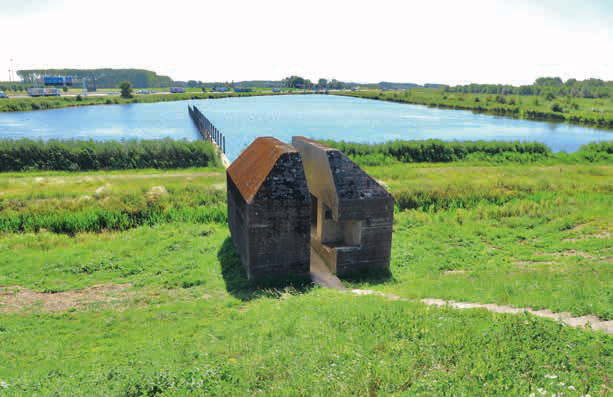Landscape authenticity
The landscape as a living system, history and spatial experience
DOI:
https://doi.org/10.48003/knob.119.2020.4.702Downloads

Abstract
Landscape authenticity relates to spatial quality and identity. Orientation in time and space are relevant, as are beauty, (multi)functionality, ecological variation and coherence. Owing to the diversity of connections and interactions between these aspects, landscape authenticity is a complex matter. This article contends that landscape authenticity can be understood by looking at the landscape as an integrated whole: as a living system, as history and as spatial experience. The landscape changes even without human intervention.
The legibility of the landscape is crucial to how it is perceived and valued. The role of time is obvious and is characterized by a selective and incremental process whereby some structures endure and are adapted, while others make way for new structures. Landscape authenticity is not about fossilizing the landscape: a landscape cannot be preserved unchanged given that it is itself the outcome of continuous transformation. Understanding the evolution of the landscape is therefore just as important as the visible result.
References
Council of Europe, European Landscape Convention, Florence, 3; zie ook: I. Zonneveld,
Land Ecology. An Introduction to Landscape Ecology as a Base for Land Evaluation, Land Management and Conservation, Amsterdam 1995.
Zonneveld 1995 (noot 1). In Noordwest-Europa zijn er lange tradities van landschapskarakterisering en fysisch-geografisch en historisch-geografisch onderzoek die zich richten op dergelijke relaties. Elk van deze onderzoeksvelden heeft zijn eigen onderzoeksperspectief en instrumentarium. Zie voor een overzicht bijvoorbeeld: M. Antrop en V. van Eetvelde, Landscape Perspectives. The Holistic Nature of Landscape, Bazel 2019.
F. Braudel, La Méditerranee. La part du milieu, Parijs 1966; S. Nijhuis en M. Pouderoijen,
‘Mapping Urbanized Deltas’, in: H. Meyer en S. Nijhuis (red.), Urbanized Deltas in Transition, Amsterdam 2014, 10-22.
P. Vrijlandt en K. Kerkstra, Mergelland. Landschap en mergelwinning, Wageningen 1976.
M. de Hoog, D. Sijmons en S. Verschuu ren, ‘Herontwerp van het laagland’, in: D. Frieling (red.), Het metropolitane debat, Bussum 1998.
Braudel 1966 (noot 3); G. Dobrov, ‘The Strategy for Organized Technology in the Light of Hard-, Soft-, and Org-ware Interaction’, Long Range Planning 12 (1979) 4, 79-90; T. Tvedt en T. Oestigaard, ‘Urban Water Systems. A Conceptual Framework’, in: T. Tvedt (red.), A History
of Water. Series III, Volume 1. Water and Urbanization, Londen 2014, 1-21.
M. Bobic, The Role of Time Function in City, Spatial Structures and Present, Aldershot 1990.
N. Roymans e.a., ‘Landscape Biography as Research Strategy. The Case of the South Netherlands Project’, Landscape Research 34 (2009) 3, 337-359.
Voor landschap als biografie, zie M. Samuels, ‘The Biography of Landscape’, in: D. Meinig (red.), The Interpretation of Landscape, New York 1979, 51-88. Voor landschap als palimpsest, zie A. Corboz, ‘The Land as Palimpsest’, Diogenes 31 (1983) 121, 21-34.
C. Sauer, ‘The Morphology of Landscape’, University of California Publications in Geography 2 (1925) 2, 19-54; D. Whittlesey, ‘Sequent Occupance’, Annals of the Association of American Geographers 19 (1929) 3, 162-165.
W. van Toorn, Leesbaar landschap, Amsterdam 1998, 65.
J. J. Gibson, The Ecological Approach to Visual Perception, Hillsdale 1986.
J.G. Granö, ‘Reine Geographie. Eine methodologische Studie beleuchtet mit Beispielen aus Finnland und Estland’, Acta Geographica 2 (1929) 2, 202.
J.F. Coeterier, Hoe beleven wij onze omgeving?, Wijchen 2000.
M. Antrop, ‘Why Landscapes of the Past Are Important for the Future’, Landscape and Urban Planning 70 (2005), 21–34.
G. Fairclough, ‘New Heritage, an Introductory Essay. People, Landscape and Change’, in: G. Fairclough (red.), The Heritage Reader, Londen 2008, 297-312.
H. Renes, ‘Different Methods for the Protection of Cultural Landscapes’, in: H. Palang e.a. (red.), European Rural Landscapes. Persistence and Change in a Globalising Environment, Dordrecht 2004, 333-344.
Published
How to Cite
Issue
Section
Articles
License
Copyright (c) 2020 Steffen Nijhuis

This work is licensed under a Creative Commons Attribution 4.0 International License.





